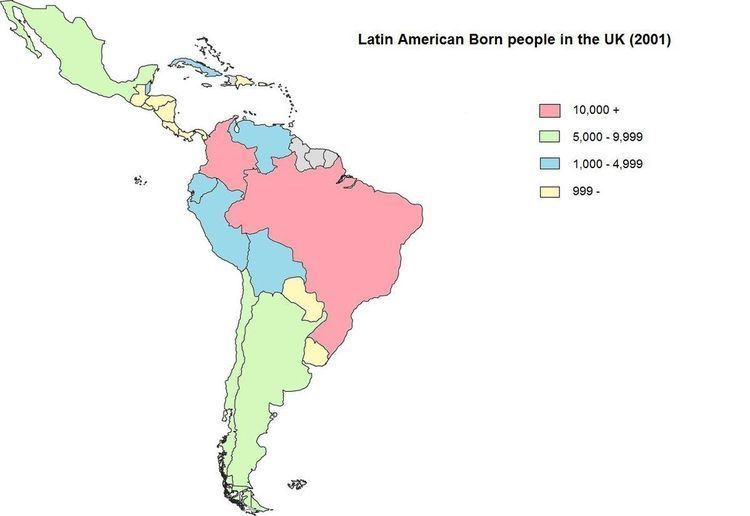 | ||
Latin American migration to Europe is the diaspora of Latin Americans to the continent of Europe, dating back to the early 19th century. Latin Americans in Europe are now a rapidly growing group consisting of immigrants from Argentina, Bolivia, Brazil, Chile, Colombia, Costa Rica, Cuba, Dominican Republic, Ecuador, El Salvador, Guatemala, Honduras, Mexico, Nicaragua, Panama, Paraguay, Peru, Puerto Rico, Uruguay and Venezuela.
Contents
Spain
Spain is the second destination of choice after the United States for Latin American migrants and the vast majority of Latin Americans in Europe are residents or nationals of this country. By 2008 Latin Americans in Spain numbered 1.8 million people and by 2014, CEPAL estimated the total number of Latin Americans in Spain at around 2.4 million. Similar figures are provided by the Spanish National Statistic Institute (INE) for 2015, counting 2,374,953 Spanish residents born in the Americas. 2015 is also the first year in which a majority (1,229,470) of Latin American-born residents in the country are Spanish citizens. It is important to highlight that, over the past decades, Spain has been the country in Europe which has naturalized the highest number of Non-Europeans in the entire European Union (23% of the total), and that its legislation is particularly favorable to Hispanic countries. Following the "Law of historic memory" Latin Americans with a Spanish parent or grandparent (and their descendants) have automatic right to Spanish citizenship, even without residing in the country. This potentially applies to millions of Latin Americans. As a result a significant and ever growing portion of Latin American immigrants have acquired Spanish citizenship due to naturalization laws and the falling number of Latin Americans residing in Spain is primarily due to them acquiring Spanish nationality and no longer being classed as immigrants. In the period between 2011 and 2013, over one million immigrants acquired Spanish citizenship and over 75% of these were Latin American. As an example, by 2014 the majority of Spain's 408,944 Ecuatorian-born residents had already acquired Spanish citizenship and were no longer included national statistics tracking immigration. As a result, Latin Americans with Spanish citizenship living in other European countries such as the UK, France or Germany benefiting from European freedom of movement and establishment for all EU citizens will be categorized as Spaniards when using nationality as a criterion to determine the country of origin (rather than country of birth) of a particular EU country's immigrant population. Despite Spain's prolonged 2008-2015 economic crisis during which the country suffered years of massive unemployment and went from having the second highest immigration rate in the world to becoming a net-emigrant country, less than 30% of Spain's Latin American immigrants have left the country during this period. As a result of the combined effect of nationalization and net emigration during the economic crisis, the Latin American resident population yet to acquire Spanish nationality fell steadily to around 900,000 in 2015.
France
Latin Americans are the second largest group of immigrants entering Europe. The most numerous are the Brazilians 44,622, followed by Colombians 40,000 and Venezuelans 30,000, Peruvians 22,002 Argentinians 11,899 and Chileans 15,782.
United Kingdom
According to the 2001 UK Census, 62,735 Latin Americans in the United Kingdom were born in their respective nations of origin. There were also a further 1,338 people who stated their birthplace as 'South or Central America' (note this would also include Guyana, French Guiana, and Suriname, which are not part of Latin America.). In 2009, the Office for National Statistics estimated that the number of Brazilian-born people in the UK alone had risen to around 60,000 and the number of Colombian-born to around 22,000. Estimates for other Latin American countries were not made because the sample size did not allow for estimation of the size of smaller groups with sufficient degree of accuracy.
Norway
From 1977 to 2012, the number of non-Norwegian citizens living in Norway of European descent has increased from around 46,000 to around 280,000. In the same period the number of citizens of nations on other continents increased from about 25,000 to about 127,000, of which 112,230 belong to Asia, Africa and South America.
Immigrants and Norwegian-born to immigrant parents, by country of origin
Portugal
In 2008, Portugal foreign population grew 1% from 435,736 in 2007 to 440,277. One in four immigrants is Brazilian. and Portugal was home for an increased amount of Venezuelans.
Switzerland
In 2013 there were a total of 1,937,447 permanent residents (23.8% of the total population of 8.14 million) in Switzerland. Of these, 51,761 were from Latin America and the Caribbean
